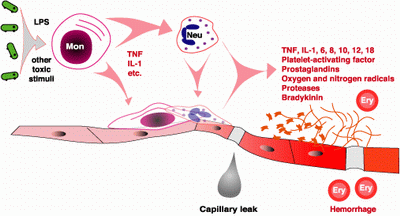Sepsis Information
Click here to scroll to the list of available medications ↓
Sepsis is an overwhelming infection that can attack any part of the body but especially can be found from infections which begin in the kidneys, gall bladder, liver, skin, bowel, and lungs. Sepsis is often referred to as SIRS, or Septic Inflammatory Response Syndrome. Sepsis attacks through the blood stream and is bacterial based in nature.
Meningitis can often be accompanied by sepsis, and patients who are hospitalized for any period of time can develop sepsis at the site of an intravenous line, surgical wound, surgical drains, or even through the development of bed sores. Children are especially prone to sepsis that stems from bone infections. Sepsis means that the original infection has become so powerful that it has spread to the bloodstream and is overpowering the body’s immune system.
Symptoms of sepsis are likely to include fever, warm skin, chills, shaking, rapid heart rate, skin rash, hyperventilation, hypothermia, confusion, delirium, or a decrease in urination. Sepsis is a life threatening infection and thus needs immediate emergency medical treatment. Sepsis can be detected when the patient seems too ill for the initial infection.

Tests are often done to confirm the presence of sepsis. It is not uncommon for a blood culture to return negative for sepsis if the patient is taking antibiotics already. This is considered an unreliable test. Sepsis can be determined if the white blood cell count is too low or too high, the platelet count is low, kidney function tests will reveal abnormalities in the early stages of sepsis, blood gases that reveal acidosis, and the presence of bacteria in the blood.
A patient with sepsis will also not be able to accurately provide for the tests discerning peripheral smears, blood differential, and fibrin degradation. Peripheral smears will show the destruction of red blood cells as well as a low platelet count. Blood differentials will return with immature white cells present, and fibrin degradation will present as elevated.
Sepsis can usually be treated in the Intensive Care Wing with intensive broad spectrum antibiotics delivered intravenously. Testing will resume as the patient stabilizes to attempt to identify the source of the sepsis. Treating the initial infection is vital in treating the sepsis, although it is not uncommon for the initial infection to clear up while the patient is receiving intravenous broad spectrum high dose antibiotics. Any abscesses require draining or surgical removal. If intravenous lines, surgical drains, or surgical wounds are the source of the sepsis, immediate removal and repair of the site is required.
Supportive therapy is often required involving oxygen therapy, fluids, and medication that can increase the patient’s blood pressure in order to help the patient through the sepsis. Even with proper treatment, it is not uncommon for patients to succumb to sepsis. 60% of all patients with underlying health conditions do not survive sepsis.
Septic shock, disseminated intravascular coagulation, and deprivation of blood and oxygen to vital organs including the heart, brain, and kidneys may complicate a case of sepsis. If a patient develops a complication, it is likely that their chances of survival decrease by at least 20%.
Avoiding sepsis is much easier than treating it. Patients who have been hospitalized for any reason should be checked daily for signs of bed sores and other sites that may develop sepsis. Patients who are recovering from a surgical procedure should be checked for signs of sepsis multiple times daily. Patients with nominal infections should be encouraged to always see a physician for infections, as self care may not always clear up the infection, especially infections of internal organs or bones.
Although the mortality rate of sepsis is quite high, many patients do survive sepsis. Post survival the patient will remain weak, fatigued, and easily exhausted for weeks or even months afterward. It takes time for the body to recover from such a detrimental infection.